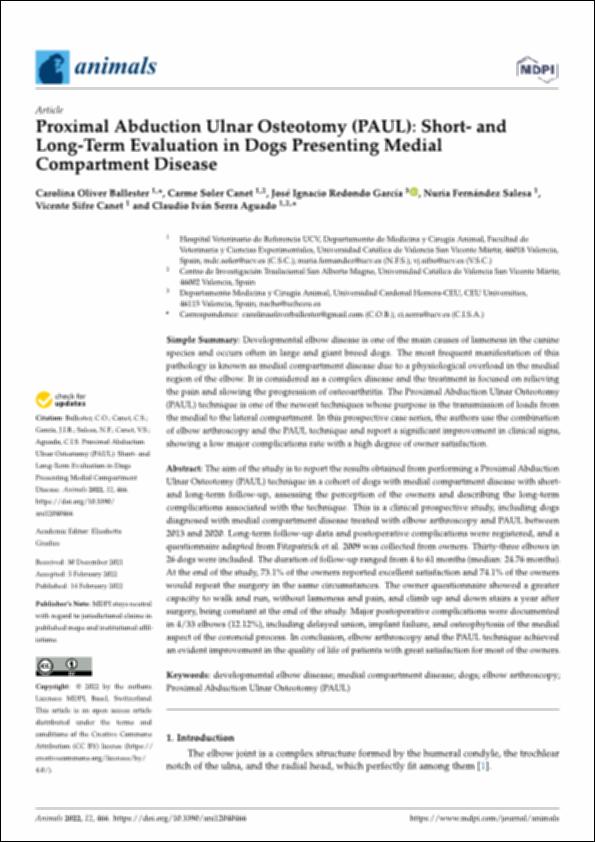Please use this identifier to cite or link to this item:
http://hdl.handle.net/10637/14146Proximal Abduction Ulnar Osteotomy (PAUL) short- and long-term evaluation in dogs presenting medial compartment disease
| Title: | Proximal Abduction Ulnar Osteotomy (PAUL) short- and long-term evaluation in dogs presenting medial compartment disease |
| Authors : | Oliver Ballester, Carolina Soler i Canet, María del Carme Redondo García, José Ignacio Fernández Salesa, Nuria Sifre Canet, Vicente José Serra Aguado, Claudio Iván |
| Keywords: | Artroscopia veterinaria.; Veterinary arthroscopy.; Perros - Enfermedades - Tratamiento.; Dogs - Diseases - Treatment.; Codos - Displasia - Tratamiento.; Cojera en los perros - Tratamiento.; Lameness in dogs - Treatment.; Cirugía veterinaria.; Veterinary surgery.; Elbow - Dysplasia - Treatment. |
| Publisher: | MDPI |
| Citation: | Ballester, C. O., Canet, C. S., García, J. I. R., Salesa, N. F., Canet, V. S. & Aguado, C. I. S. (2022). Proximal Abduction Ulnar Osteotomy (PAUL): short- and long-term evaluation in dogs presenting medial compartment disease. Animals, vol. 12, i. 4 (14 feb.), art. 466. DOI: https://doi.org/10.3390/ani12040466 |
| Abstract: | The aim of the study is to report the results obtained from performing a Proximal Abduction Ulnar Osteotomy (PAUL) technique in a cohort of dogs with medial compartment disease with shortand long-term follow-up, assessing the perception of the owners and describing the long-term complications associated with the technique. This is a clinical prospective study, including dogs diagnosed with medial compartment disease treated with elbow arthroscopy and PAUL between 2013 and 2020. Long-term follow-up data and postoperative complications were registered, and a questionnaire adapted from Fitzpatrick et al. 2009 was collected from owners. Thirty-three elbows in 26 dogs were included. The duration of follow-up ranged from 4 to 61 months (median: 24.76 months). At the end of the study, 73.1% of the owners reported excellent satisfaction and 74.1% of the owners would repeat the surgery in the same circumstances. The owner questionnaire showed a greater capacity to walk and run, without lameness and pain, and climb up and down stairs a year after surgery, being constant at the end of the study. Major postoperative complications were documented in 4/33 elbows (12.12%), including delayed union, implant failure, and osteophytosis of the medial aspect of the coronoid process. In conclusion, elbow arthroscopy and the PAUL technique achieved an evident improvement in the quality of life of patients with great satisfaction for most of the owners. |
| Description: | Este artículo se encuentra disponible en la página web de la revista en la siguiente URL: https://www.mdpi.com/2076-2615/12/4/466 Este artículo de investigación pertenece a la sección "Companion Animals". |
| URI: | http://hdl.handle.net/10637/14146 |
| Rights : | http://creativecommons.org/licenses/by/4.0/deed.es |
| ISSN: | 2076-2615 (Electrónico) |
| Issue Date: | 14-Feb-2022 |
| Center : | Universidad Cardenal Herrera-CEU |
| Appears in Collections: | Dpto. Medicina y Cirugía Animal |
Items in DSpace are protected by copyright, with all rights reserved, unless otherwise indicated.


